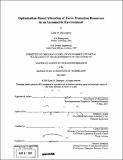Optimization-based allocation of force protection resources in an asymmetric environment
Author(s)
DeGregory, Keith W. (Keith William)
DownloadFull printable version (33.82Mb)
Other Contributors
Massachusetts Institute of Technology. Operations Research Center.
Advisor
Cynthia Barnhart.
Terms of use
Metadata
Show full item recordAbstract
More than four years after the end of major combat operations in the 2003 Iraq War, the United States military continues to sustain casualties at rates higher than those during the ground campaign. Combat service support soldiers conducting daily convoy operations on the Iraqi road network account for a large number of these casualties. One reason for this is the threat's affinity to targeting soft, vulnerable, high-payoff targets through the use of roadside bombs, otherwise known as improvised explosive devices. This enemy tactic is characteristic of asymmetric warfare, in which a lesser opponent opposes a force far superior in numbers, equipment, and technology. In an asymmetric operating environment, threats blend in with the local populace making them hard to detect and are easily capable of multi-directional attacks; absent are the linear battlefields of past wars where logistical soldiers operated in the relative safety of the rear battlefield. This thesis explores a mathematical approach to decide how to use available resources to best protect logistical convoys. To achieve this we first model the threat using probabilistic models and identify input data requirements associated with the operating environment and other relevant factors. (cont.) Second, we identify a set of force protection resources and model their counter-effects on the threat. Next, we develop a binary integer program to optimally allocate the force protection resources to a set of planned logistical convoys. Our model uses an algorithm that assigns resources to either fixed areas or individual convoys in a way that minimizes overall threat effects to the convoys. The algorithm provides lower-risk plans yielding a lower expected number of casualties. We propose integrating this force protection algorithm in conjunction with convoy planning software that optimally builds and routes convoys based on minimizing exposure to the threat to achieve even better plans. We test the performance of a system that accomplishes this by comparing its resulting plans to human-generated plans in a controlled experiment. Additionally, we conduct Monte Carlo simulations to statistically analyze the system's performance. We find that the system produces lower-risk plans in less time than human planners. We describe future development of this methodology to reducing soldier casualties, and a proposed approach for its integration into existing Army systems and processes.
Description
Thesis (S.M.)--Massachusetts Institute of Technology, Sloan School of Management, Operations Research Center, 2007. Includes bibliographical references (p. 137-138).
Date issued
2007Department
Massachusetts Institute of Technology. Operations Research Center; Sloan School of ManagementPublisher
Massachusetts Institute of Technology
Keywords
Operations Research Center.